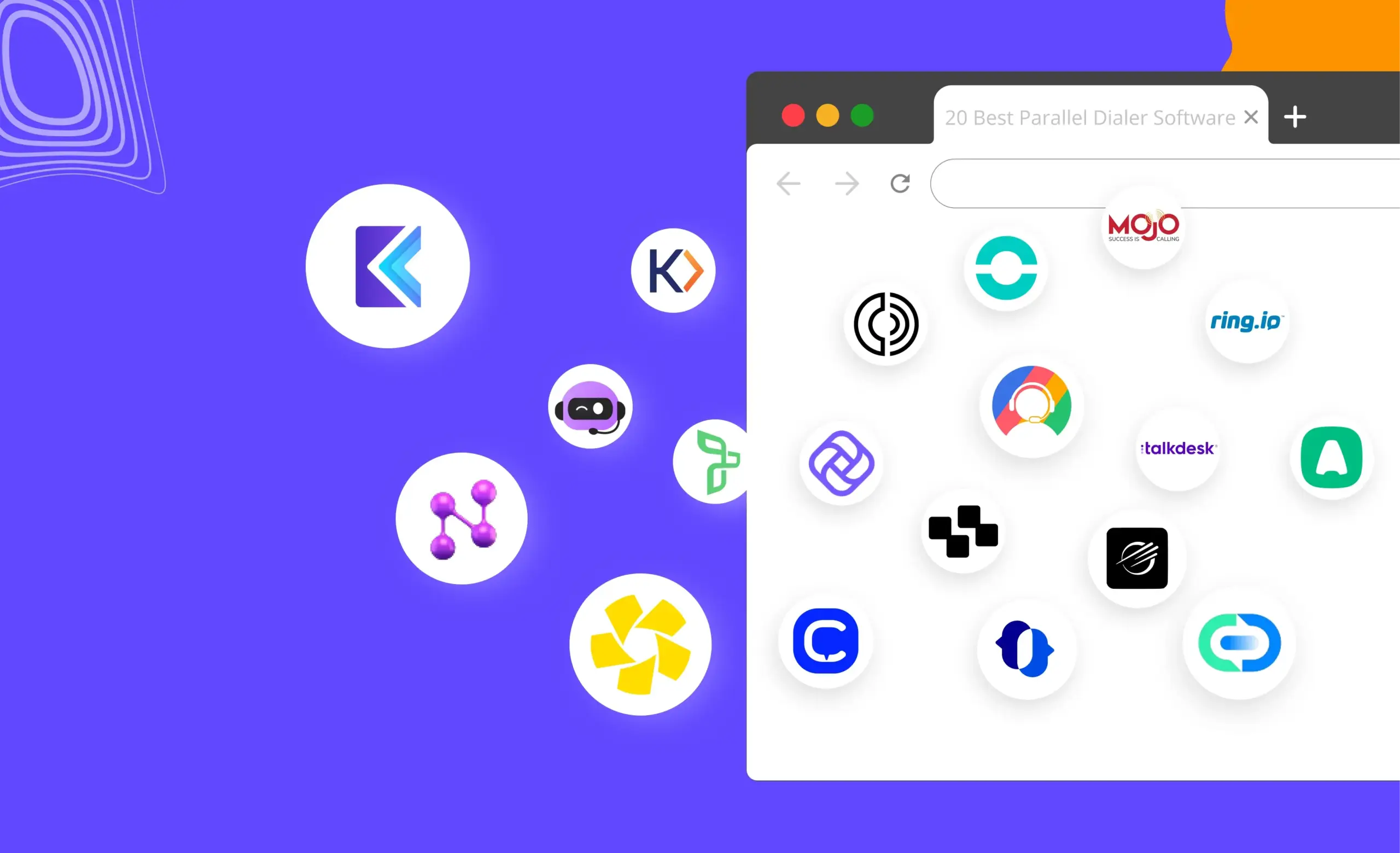Cold calling. Virtually every sales influencer you know would grouse and groan about it.
They tell you that calling is dying, or dead already. Or that businesses no longer see calling as viable for sales.
But this is far from the truth. As far as far can be.
As per a global survey of over 12,000 respondents across 6 countries, 66% of companies said voice calls were “essential” or “very important” to achieving their goals, such as making sales.
What’s more, the survey also reveals that calling beats email and texting when it comes to communicating about sensitive information or critical business decisions.
Then why does cold calling have a bad reputation? What’s the right way to cold call?
We answer all of your questions and more in this ultimate guide to cold calling.
Key Points
- Cold calling is a sales prospecting method which involves sales reps contacting potential buyers using the phone to pitch their solution. The call is cold because the rep calls a prospect with whom they had no prior contact with.
- B2B cold calling still works as a prospecting strategy only if you focus on first learning about the prospect’s specific goals and pain points and use the cold call to genuinely help them solve their pain points.
- The 6 steps to make a cold call are: Create prospect list, research, craft an opener, create a cold call script, prepare to handle objections, and practice before you call.
- Some best practices to make your cold calling successful are: Practice active listening, find the best time to call your prospects, personalize your call script, comply with cold calling laws, and overcome cold call anxiety with the right mindset.
- Given that SDRs make 60-100 cold calls every day, it’s difficult to do all this manually. So, automate your cold calling process with a cold calling tool.
- Good cold calling software should come with automatic dialing, strong CRM integration, automatic scheduling, track key cold calling metrics to give you reports, and conversation intelligence for note-taking.
What Is Cold Calling?
Cold calling is a sales prospecting method which involves sales reps contacting potential buyers using the phone to pitch their solution. The call is cold because the rep calls a prospect with whom they had no prior contact with.
One of the oldest prospecting techniques out there, cold calling is at least a 100 years old—almost as old as the telephone itself.
Which is why many salespeople see cold calling as something that’s old-school, and therefore, classify it as obsolete. They make bold assertions like, “Cold calling is dead!” or “You should stop cold calling immediately.”
On the surface, it looks like they have a good reason to crap all over cold calling. Take a look at these numbers from LinkedIn:
- 63% of sellers say cold calling is the worst part of their job.
- Cold call conversion rates hover around just 2%.
- A cold calling rep should make at least 18 dials to reach a tech prospect.
This begs the question:
Does Cold Calling Still Work?
Short answer: Yes, B2B cold calling still works as a prospecting strategy only if you focus on first learning about the prospect’s specific goals and pain points and use the cold call to genuinely help them solve their pain points.
On to the long-ish answer. Before we tackle the larger question of whether cold calling still works, let’s first answer the smaller question: Is cold calling dead?
Yes. And no.
The traditional cold calling is dead. By this, we mean salespeople simply dialing numbers on a list to pitch their product without bothering to learn about each prospect’s pain points, motivations or goals.
But, the cold calling of today has evolved into a far more sophisticated outreach method. One that involves creating targeted lists, carrying out extensive pre-call research, and personalizing the value proposition. This kind of cold calling is alive and thriving.
Need more proof? Here are a few eye-opening cold calling statistics for you:
- 70% of sellers connect with buyers and generate meetings using the phone
- 57% of C-level and VP-level buyers across industries prefer the phone.
- Organizations that didn’t cold call experienced 42% less growth than those that did.
Now that you’re convinced that cold calling is definitely not dead, let’s now get to the big question: Does cold calling still work?
Cold calling still works if you want to:
- Target C-suite and VP-level decision makers, as they prefer answering cold calls more than others, as per research by RAIN Group.
- Gauge your prospect’s reaction better. No other sales outreach method lets you gauge if your pitch is working in real time as well as cold calling does.
- Build better rapport with your prospects, as cold calling adds a more personalized, human touch to your sales outreach.
Cold Calls or Cold Emails: Which Is Better?
Sure, cold calls work. But what about cold emails?
When it comes to cold email vs. cold call, which one should you go for?
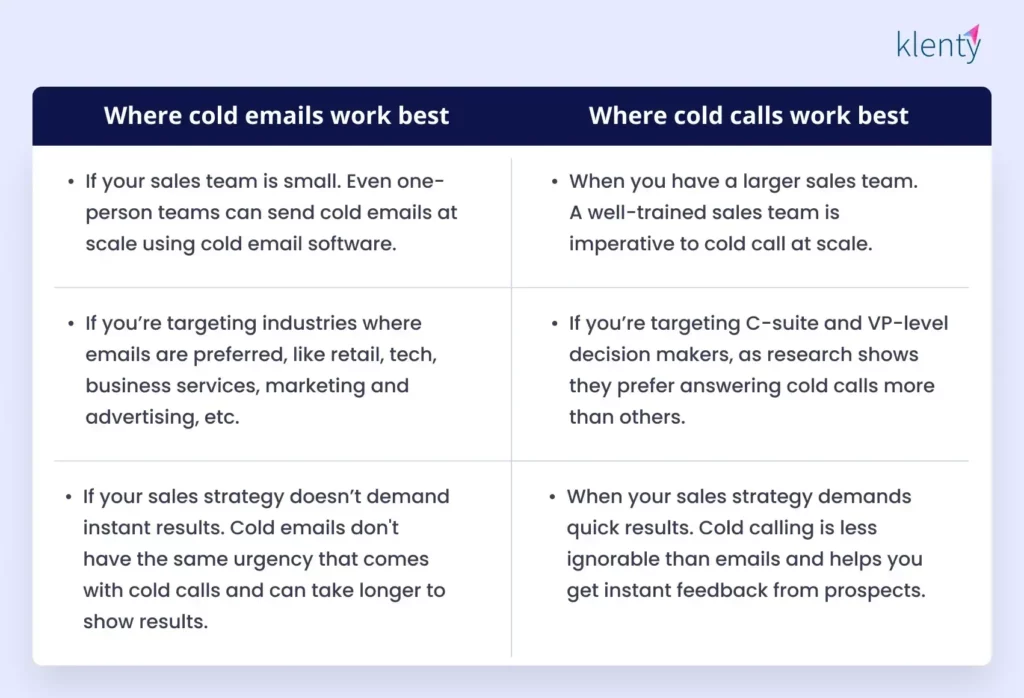
Cold emails work best if your:
- Sales team is small. Cold email campaigns don’t require a large human resource, given one person can send cold emails at scale with sufficient training and access to cold email software.
- Target industries prefer emails. People working at mid-market and enterprise-level companies might prefer cold emails to cold calls, given the point-of-contact employees or gatekeepers don’t like interruptions while working. Additionally, companies in retail, tech, business services, and marketing and advertising, among others, are more likely to respond to cold emails.
- Sales strategy doesn’t demand instant results. Cold emails don't have the same urgency that comes with cold calls and can take longer to show results. So, it’s more suitable if you’re focused on building long-term connections with prospects.
However, there’s no real rivalry between cold calling and cold emailing.
As per McKinsey and Company, B2B customers can use up to 10 different channels before making a purchase decision. So, having a multichannel outreach approach by combining cold emails and cold calls can be the best way to engage all your target prospects.
Don’t take it just from us. Hear what David Dulany, Founder & CEO of Tenbound, has to say on cold calling:
“In the competitive market we live in, you want to use every measure possible to get into the conversation and ensure that buyers know that you are one of the players in the space and one of the top players and/or solving the specific issues that they’re having.
So it starts with really knowing your industry now, knowing the vocabulary and becoming a student of the problems that your potential buyers have. That way when you make the call, you can be talking about how you can help them to solve problems and introduce one of the options which is your solution.”
How To Make a Cold Call? 6 Steps You Need To Follow
Now that you know why and when cold calling works, let’s get to the how.
While there’s clinching evidence that cold calling works for SDRs, it doesn’t negate the fact that cold calling is hard. Hardly 2 out of 100 cold calls you make might result in positive outcomes, like booking a meeting.
So, not having a solid approach to your cold calling process is going to make things only harder.
Fear not. Below, you’ll find the 6 steps that’ll help you streamline your cold calling process and boost your call success rates:
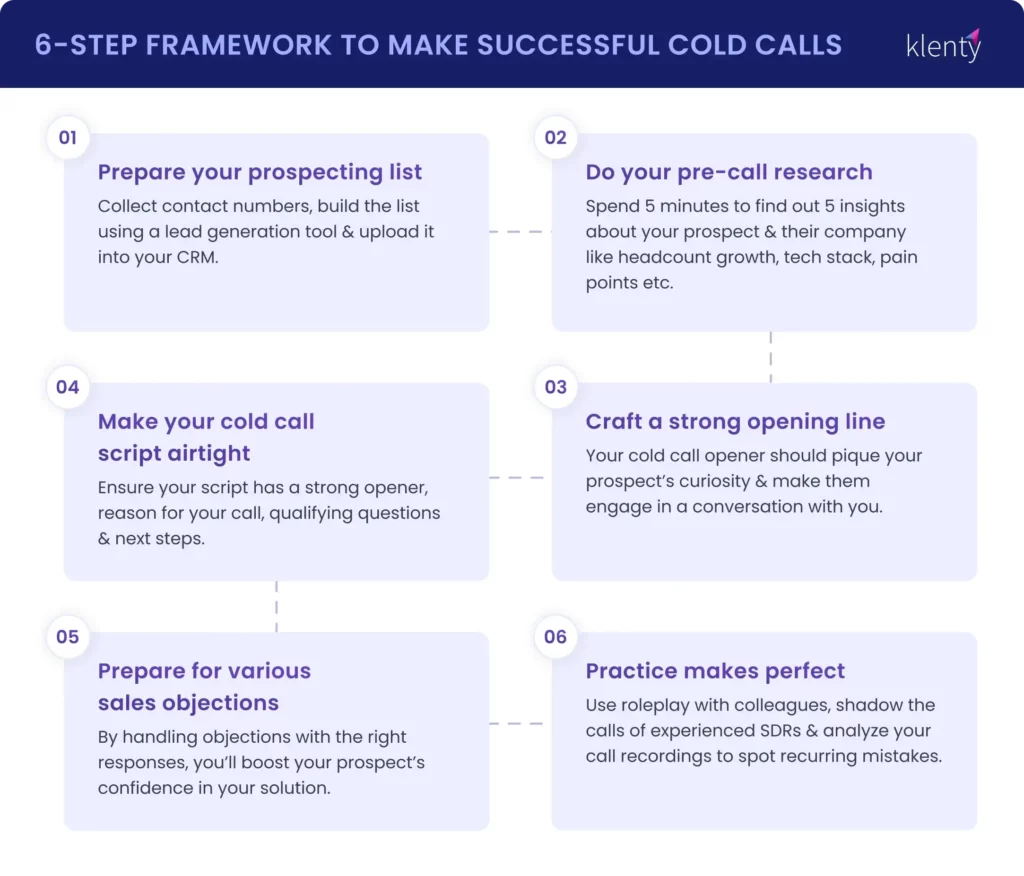
1. Create a Targeted Prospect List
A sales prospecting list is a repository of information about your potential customers, like their names and contact details, usually represented in the form of a data sheet. Sales teams use these lists for outreach campaigns.
Before you pick your phone and start cold calling, you need to build a targeted list of prospects by following these key steps:
- Define your ICP. Ideal Customer Profile (ICP) is a detailed and semi-fictional representation of the perfect customer for your business. Identify the list of companies that suit your ICPs and take stock of all key decision-makers within these companies.
- Collect contact information. Next, you must get each prospect’s contact information—phone numbers, email addresses, social media handles, etc. Use a B2B contact database tool to get these details quickly and efficiently.
- Upload your list into your CRM. Doing this lets you easily access, edit, and view all prospect data in one place.
- Strategize your outreach. Prepare a clear plan for whether you’re reaching out to prospects in batches, how often you want to follow up, what the next course of action should be for each touchpoint and response, and all the different approaches you’ll use in your outreach.
2. Research, Research, Research
Solid research on your prospect is something that you can’t do without in your pre-call planning. It dictates everything about your cold calling—from how you build rapport to personalizing your sales pitch.
In short, the quality of your research is what differentiates a good cold call from a spammy telemarketing call. (No offense, telemarketers.)
Here’s a 3-step approach to get the maximum out of your pre-call research:
- Set a time limit for research. Allocate a maximum of 3-5 minutes per prospect. This is important so that you can avoid falling into a research rabbit hole. Focus only on gathering important information within the time limit.
- Start with the prospect’s socials. Pay attention to their recent posts, professional background, and shared connections. Use this information as conversation starters to build rapport.
- Use sales intelligence tools. Look for insights on their company’s tech stack, about recent funding rounds and other pertinent company-level developments to tailor your sales pitch.
Pro tip: Kyle Coleman, renowned B2B sales leader, recommends the 5x5 method: Take 5 minutes to find 5 key insights about your prospect. You can cover all key details about your prospect while saving time.
3. Craft a Strong Cold Calling Opener
Your cold calling opening line is what hooks the prospect’s attention in the first few seconds of your call. If your opener is good enough, you’re bound to get a few minutes of their time and have a successful cold call. So, spend some time and come up with a convincing opener.
Here are a few things to keep in mind when you’re crafting your cold call opener:
- Focus on the tone of voice. Talk as if you’re asking for help. At the same time, deliver your opener with confidence and unwavering conviction.
- Introduce yourself. Include your full name and your organization in your opener.
- Use pattern interruption. To get their attention from the get-go, say something that you normally wouldn’t say. Here’s an example: “I’ll be upfront—this is a cold call. It’s up to you: You can either hang up now or let me briefly tell you why I called and then decide.”
4. Have a Winning Cold Call Script
Once you’ve got your opener down, it’s time to focus on your cold calling script.
A cold calling script helps you chart the course of your conversation and helps you structure your calls better. This kicks ambiguity out of the scene, helps you be mindful of what you say, and pitch your message clearly.
Here's our simple 4-step framework to help you create your winning cold calling script:
- Begin with a strong opener. Your openers should achieve 2 things: Get your prospect's attention and intrigue them enough to stay on the call.
- State the reason for your cold call. Once you have your prospect's attention, tell them why you are calling. Remember: The reason for your call is never to pitch your product. Instead, find a segue that you can use to start a conversation with your prospect and organically introduce your product.
- Find if they’re ready to buy. Ask your prospect a series of qualifying questions to know if they’re problem-aware, if solving the problem is a priority, and if they already have a tool in place for the problem.
- Take the next steps based on intent. Based on their answers and sales-readiness, segment your prospects into high-intent prospects and low-intent prospects. For high-intent prospects, the next step is to book a meeting with you. The next step for low-intent prospects is adding them to an email nurture sequence to stay on top of their mind when they’re ready to buy.
5. Prepare To Handle Objections
Obviously, not every prospect who answers your cold call will be sales-ready. These prospects will pose objections, which are basically reasons why they don’t want to buy from you.
So, learning to handle cold calling objections becomes essential—not optional—for you to book their meetings through cold calling.
Some of the common cold calling objections you might encounter are:
- “I’m not interested.”
- “Send me an email.”
- “We’re using another tool.”
- “I don’t have time.”
- “We don’t have the budget.”
- “How did you get this number?”
Anticipating these objections, prepare the right responses and incorporate them into your cold calling script. This way, you won’t be caught unawares when your prospect gives you one of these objections.
By handling objections, you’ll boost your prospect’s confidence in your solution. Sometimes, all that stands between you and a booked meeting is just an objection.
6. Practice Makes Perfect
Here’s a truth bomb: An ace cold caller isn’t made in a single day or a single call.
The above statement might have sounded obvious, but it’s important that you realize it as the truth. It takes continuous practice to become good at anything, and cold calling is no exception to this.
Here are some cold call training methods you can use to practice your cold calling skills:
- Roleplay with colleagues. Use your cold calling script and try it out on a colleague during a roleplay session. Ask them to score you on parameters like tone of voice, how well do you improvise, and objection handling.
- Shadow calls of experienced reps. Shadow a top-performing SDR while they’re cold calling to see how they successfully book meetings.
- Analyze call recordings. Sit with your sales manager and play the recordings of your cold calls so that they can spot your recurring mistakes and other areas that need improvement. Use a conversation intelligence tool for this exercise to review calls faster.
Example of an Expert-Approved Cold Calling Script
Stephan Schiffman is a corporate sales trainer, who’s trained over 500,000 salespeople across firms including AT&T and U.S. Healthcare.
He’s condensed his training programme into a super helpful book for cold callers titled Cold Calling Techniques (That Really Work!).
In the book, he outlines the 5 basic elements of a cold call:
- Get the person’s attention: Start with a greeting and mention the prospect’s name. Saying their name is the most foolproof way to get their attention.
- Identify yourself and your company: Don’t stop with mentioning your company name alone. Give a brief introduction, or commercial, about your company.
- Give the reason for your call: Be straightforward that you’re calling to book a meeting, but paint a compelling picture on why they should come to a meeting with you.
- Make a qualifying statement: Include a statement that’ll make the prospect respond favorably to you. Mention a benefit and namedrop a big customer of yours that they’d know.
- Set the appointment: Make the request direct, brief, and specific.
Putting these 5 elements together, he gives the best cold call script you can use:
Good morning, [prospect name].
This is [your name] from [your organization] here in [location]. We’re a [brief description of what your company does].
The reason I’m calling you today specifically is so I can stop by and tell you about our new [solution] and how it can [benefit]
I’m sure that you, like [your customer], are interested in [benefit].
(Positive response.)
That’s great, [prospect name]. I think we should get together. How’s [day] at [time]? Top 10 Cold Calling Tips to Ace Prospecting on the Phone
When it comes to cold calling, the most important thing you need to know is that there’s no magic bullet.
From the sales experts you follow on LinkedIn to the senior SDR in your team, every single salesperson has experienced rejections in cold calling every single day when they started out.
They are where they are because they consistently took steps to improve their calling performance. They worked out strategies and approaches and stuck with those that showed results.
And you can (rather, should) do the same thing to become an ace cold caller.
As a jumping-off point, here are 10 cold calling tips and techniques that you can apply to your outbound calling process right away.
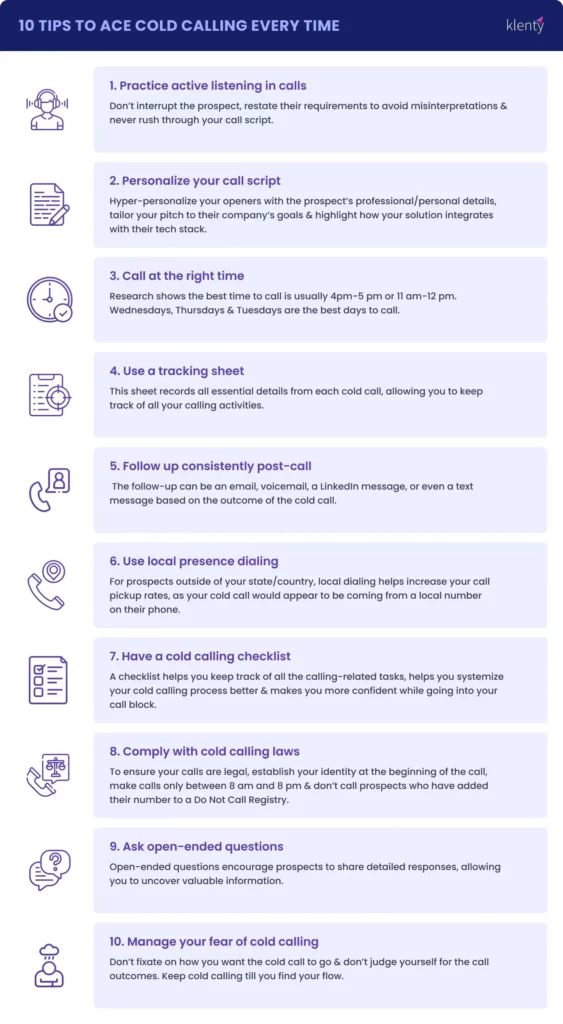
1. Practice Active Listening
Active listening in cold calls is a communication skill that involves fully focusing on, understanding, and responding to prospects during your conversations.
By practicing active listening, you demonstrate your intent to understand your prospects and address their specific requirements. The result? The prospect will come to trust you better and be inclined to continue the conversation further, and you'll get that meeting booked.
Like everything else in sales, active listening is a skill that can be practiced and improved. Here are 3 ways you can practice active listening:
- Don’t interrupt. By allowing the prospect to speak without interruption, you show respect for their opinions and create an atmosphere of openness. This allows you to gather more information about their pain points and goals.
- Restate what you hear. When a prospect shares their challenges or what they're seeking, say, "If I understand correctly, you mentioned that one of your main challenges is…" and briefly state what you have understood. This reassures the potential customer that their thoughts are being accurately interpreted.
- Don’t rush through your cold call script. While having a script is beneficial for maintaining structure, it's essential not to rush through it. Be flexible, and allow the conversation to unfold naturally. This adaptability demonstrates that you’re responsive to the prospect's needs and not just following an ossified script.
2. Personalize Your Call Script
Today, personalization matters more than ever, no matter which outreach channel you use. A McKinsey study reveals how 71% of consumers expect companies to deliver personalized interactions.
So, here are some effective strategies to help you personalize your cold calls:
- Create hyper-personalized openers. Making your cold call openers hyper-personalized helps you instantly catch your prospect’s attention. You can reference either their professional details like their role and responsibilities or personal details like their interests, hobbies, and education.
- Use company information. Tailor your pitch to the prospect's specific needs, challenges, and goals with information about their company. These are details like their company’s employee size, industry, and recent news events.
- Mention their tech stack. You can also tailor your pitch to highlight how your solution integrates seamlessly or improves upon the prospect’s existing tech stack. This approach immediately resonates with prospects, as it addresses specific challenges they might be facing.
3. Call at the Right Time
As cold calling is widely perceived to be an intrusive practice, the difference between a successful cold call and a line left ringing has much to do with timing. So, it’s worth knowing the best times to make cold calls.
As per an analysis by CallHippo of 15,800 call attempts, the best time to make sales calls prospects is between 4 p.m and 5 p.m.
The second-best time, according to the same study, is between 11 a.m and 12 p.m, right before lunch.
Another key finding here is that Wednesday is the best day to make cold calls, followed by Thursdays and Tuesdays.
4. Use a Tracking Sheet
A cold calling tracking sheet is a document that allows you to track the progress of your and your sales team’s cold calls.
Some benefits of using a tracking sheet include:
- Measure the quality of your call scripts and test different sales messaging.
- Track the progress of each SDR and the sales team against daily and weekly goals.
- Helps sales teams stay on top of the post-call follow-ups.
- Allows SDR managers spot reps who need help with their conversations.

5. Follow Up Consistently
All SDRs can attest to the fact that most meetings don’t get booked in just one cold call. But, 44% of salespeople don’t even make a single follow-up attempt after the initial call.
So, strategic and consistent cold call follow-ups are essential to reach your prospect.
The follow-up can be an email, voicemail, a LinkedIn message, or even a text message that you use to reach out to your prospect based on the outcome of the cold call.
You can gauge which touchpoint will help move the sales process forward and convince the potential lead that your business is the right choice for them.
6. Use Local Presence Dialing
If you’re cold calling prospects who are out-of-state or out-of-country and find that your pickup rates aren’t great, chances are your prospects aren’t picking up simply because you’re calling from a different region.
Here’s where local presence dialing comes to your rescue.
By using a dialing platform that enables local presence dialing, you can reach out to your prospect using their own local area code. This way, when prospects see your number flash on their phone, the call appears to be coming from a local number.
And studies show that prospects are 4 times more likely to answer calls from local numbers.
With local presence dialing, you can be confident of reaching prospects wherever they are in the world, and get more meetings booked.
7. Have a Cold Calling Checklist
As you might have experienced, cold calling isn’t only about calling—it entails multiple tasks.
You need to prepare your sales prospecting list, do your pre-call research, review your call script, update the tracking sheet, follow up with the prospects…that’s quite a heap!
So, keep track of all these to-dos with a cold calling checklist. A checklist helps you systemize your cold calling process better and makes you more confident while going into your call block.
To ensure you don’t miss anything in your checklist, divide your tasks among the 3 stages of cold calling: pre-call, during the call, and post-call.

8. Comply With Cold Calling Laws
Is cold calling legal? Of course, yes. (Otherwise, this whopper of an article could only be found in the dark net.)
But there’s a reasonable restriction: Cold callers must comply with global laws and regulations that protects the privacy of consumers and prevents unsolicited communications. Examples of these laws include:
- General Data Protection Regulation (GDPR) in the European Union
- Telephone Consumer Protection Act (TCPA) and Telemarketing Sales Rule (TSR) in the United States
- Privacy and Electronic Communications Regulations (PECR) in the United Kingdom
Cold calling regulations vary depending on the region or country. But irrespective of whether you’re cold calling prospects next door or across the globe, here are some best practices you must follow:
- Establish your identity at the beginning. Within the first 2 minutes of the prospect picking up your cold call, make sure you disclose your name and company, and the purpose of your call.
- Know the cold calling hours. As a rule of thumb, call prospects only during regular business hours (typically between 8 a.m and 8 p.m) and avoid calling on weekends and public holidays.
- Cross-check your prospect list. Ensure you’re not calling prospects who have added their number to a Do Not Call Registry.
9. Ask Open-Ended Questions
To strike up a meaningful conversation with your prospects and book more meetings, you need to ask the right cold calling questions during cold calls.
As a general principle, stick to asking open-ended questions from start to finish of your call. Open-ended questions get prospects talking and keep the dialogue going, so that you can have quality conversations.
The opposite of this is closed-ended questions, which can simply be answered with a yes or no. Keep these to a minimum, as asking too many yes/no questions can make the call feel like an interrogation instead of an interaction.
Example of a closed-ended question: “Are you the decision maker?”
Example of an open-ended question: “May I ask you how many people are involved in decision making in your organization?”
10. Conquer Cold Calling Anxiety
Are you haunted by cold calling anxiety? You’re not alone.
Every second B2B salesperson is afraid to make cold calls, a study reveals. Think of the biggest names you know in sales. All of them must have felt a pang in their gut when they picked up the phone the first few times.
It’s natural to feel this fear of cold calls. As humans, we all fear rejection and failure. But you shouldn’t let that deter you from your prospecting efforts. After all, nothing happens until someone sells something.
So, how do you get over the fear of cold calling?
Sales expert Josh Braun recommends 2 strategies to conquer cold call anxiety:
- Observe calls without judgment. Don’t fixate too much on how you want the cold call to go. Rather, observe your calls as you’re doing it without judging yourself.
- Do it afraid. Fear and excitement aren’t all that different. So, if you’re afraid of cold calls, go ahead and still do it as you would participate in an adventure sport. Eventually, you’ll find your flow and manage your fear better.
Why Do You Need a Cold Calling Tool?
As essential as cold calling is to bring new sales, manually doing all your cold calling tasks can drain your focus.
Think about it. You build lists manually. You research prospects manually. You pick your phone up and dial prospects manually. Once the call’s over, you log the call details into your CRM manually. And you execute your follow-up touchpoints manually.
Manual cold calling might work if you’re making only a dozen or a score calls a day. But a B2B sales rep is expected to make at least 60 calls per day as a benchmark to improve the chances of booking meetings. And high-performing sales teams make over 350 cold calls every day.
So, if you want to book meetings predictably to build an effective sales pipeline, you can’t afford to rely on doing things manually.
You need to automate your cold calling process with cold calling software.
A cold calling software schedules your daily calls, measures cold calling metrics, and prioritizes calls based on varying levels of a prospect’s engagement.
Cold calling tools help you automate mundane tasks like dialing numbers, logging call details into CRMs, scheduling follow-ups, and note-taking, so that you can reach a large number of prospects and maximize your meetings booked.
Here are 5 factors you need to evaluate when choosing a good cold calling tool:
- Automatic dialing to eliminate manual dialing so that you can call all your prospects in one go automatically.
- Deep CRM integration to ensure automatic bidirectional flow of data between your cold calling tool and your CRM, thereby avoiding manual logging of calls.
- Call scheduling that lets you automatically schedule calls when prospects show intent.
- Access to call metrics to keep track of your call quality and volume.
- Conversation intelligence to help you take accurate notes automatically during calls.
And which cold calling tool gives you all the above and more? The answer, dear cold caller, is just a scroll away.
Book More Meetings With a Robust Sales Dialer
Gone are the days when sales reps needed to manually punch numbers into a phone. Or plod away with click after click to place every call.
To blitz through your cold calls like a pro day after day, you need a robust sales dialer. And Klenty gives you just what you’re looking for.
With Klenty’s Sales Dialer, you can call 5x faster. This means more cold calls. More prospects contacted per day. More quality conversations. More time to research accounts. And more meetings booked.
Klenty is the only sales engagement platform that offers a Multi-Mode Calling Experience.
With multiple modes of calling (Parallel Dialing, Power Dialing and Focus Dialing) to choose from, sales reps can pick the dialer that best suits their calling workflows.
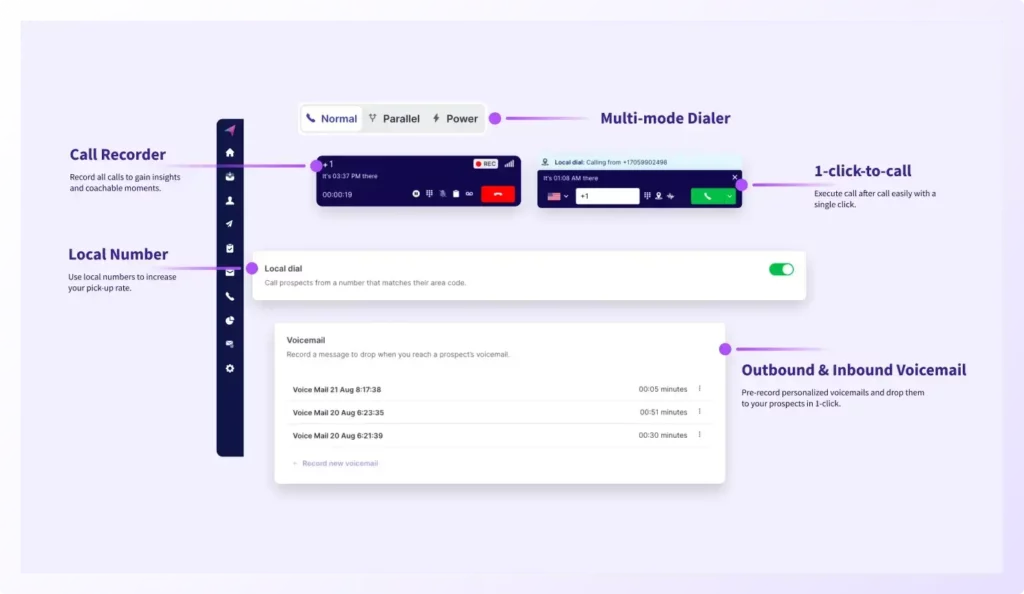
Here are some key features of Klenty's Sales Dialer:
- Parallel Dialer: Dial up to 5 prospects simultaneously. With Parallel Dialer, you’re guaranteed to make over 300 cold calls in just one hour.
- 1-click-to-call Dialer: Eliminate manual dialing. Place call after call like clockwork.
- AI-powered note taking: Let AI take notes for you on call. Review calls in minutes with Auto-Summarization. Sync all your call notes to CRM.
- Tight integrations with 5 CRMs. Klenty smoothly integrates with Salesforce, MS Dynamics 365, HubSpot, Zoho, and Pipedrive CRMs. Sync all your calling activities, notes, and tasks to your CRM automatically.
- Call Recording to review calls at your convenience.
- Voicemail Drop to send personalized, pre-recorded voicemails with 1 click.
- Local Dial to place calls to your prospects using their area code.
- Call Outcome to mark the status of each call instantly.
- Incoming Voicemail to allow prospects to leave you a voicemail.
- Call Reports to measure your performance and find coachable points.
In addition to calling, Klenty enables you to plan, execute, and track multichannel outreach across 5+ channels and persistently follow up—all at scale. Send the right message across the right channel at the right time.
Ready to skyrocket your cold calling to the stratosphere? Book a demo now to see Klenty’s Sales Dialer in action!


